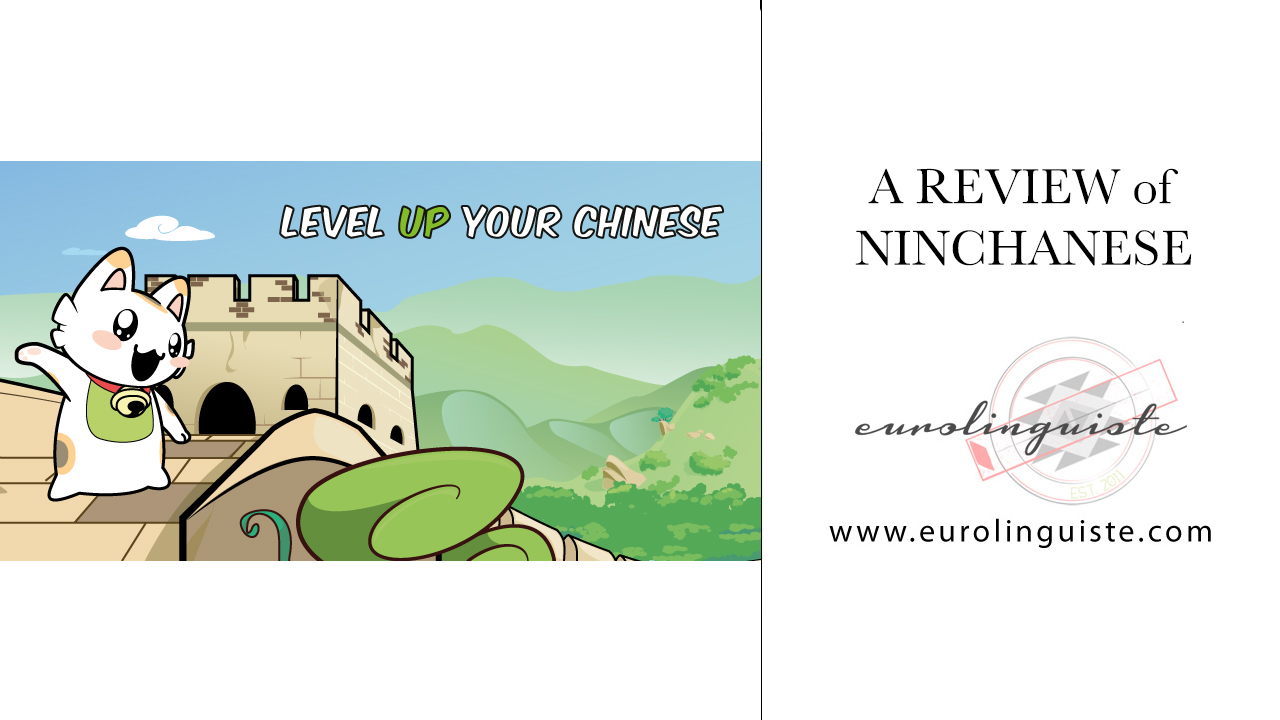Behind the Scenes of Developing a Language App with Sarah Aberman of Ninchanese

My name is Shannon Kennedy and I'm the language lover,…
A while back I had the opportunity to try out and review what has become one of my favorite language learning apps, Ninchanese. One of the co-founders, Sarah Aberman, graciously agreed to join me and discuss her experience designing a language learning application and how she uses her personal experience as a language learner to create a great tool for other learners of Chinese.
For those of you unfamiliar with Ninchanese, it is a game-based language learning app for Mandarin Chinese learners that utilizes storytelling and beautiful graphics to immerse you in a fun, web-based learning environment. They’re launching their Kickstarter campaign today, so don’t miss out on getting access to their awesome incentives. I know that I won’t!
The Transcription of Our Interview with Sarah Aberman of Ninchanese
Hey guys! Bonjour! This is Shannon Kennedy from Eurolinguiste.com. Today I’m going to do something a little bit different than usual. Today I’m going to be interviewing Sarah Aberman from Ninchanese. It’s a gamified language learning tool from Mandarin Language Learners and today we’re going to talk about what it’s like developing a language learning app and how she applies her personal experience, having learned the Chinese language, to developing that app.
So, I hope you enjoy the interview!
SA: Well, hi everyone! So, I’m Sarah. I’m French-American and I’ve always loved learning languages. I actually started learning Chinese when I was in middle school… I’ve been learning Chinese ever since middle school. So it’s been a while. After we got… I went to China several times during my studies and the last time after I went to China I started working and I didn’t have anything to do with Chinese any more and then I started looking for something to keep my Chinese up and keep practicing and I just didn’t find what I was looking for. So, with my partner, we decided to sort of build our own little prototype and it turned out into a learning app.
SK: Why did you decide to start learning Chinese in middle school? Our language choices are usually, like, French or Spanish. Chinese is kind of unusual to choose, especially for someone around our age. What made you decide to take Chinese?
SA: It was really kind of random. At the time I was studying English and German and Spanish, but Chinese was just like a lunchtime activity. We’d, I guess he [her teacher] was into Chinese at the time so he just had fun to show us how to draw characters and stuff like that. So I guess the really casual setting as well made it something fun to do and then I wanted to continue. So, it wasn’t common then in France either, so it’s really just by chance.
SK: So, you developed Ninchanese to create a tool to help you review Chinese, I guess, as you said. How did you come up with the ideas for the characters? They’re so adorable and just, like, having the app as a game and the whole storyline and stuff like that.
SA: To be honest, my partner and I, we found a study that said that you learned better if you’re in an emotional setting, basically if you engage with the characters. The cuter it is, then the better you learn. It’s kind of cool really that we can do whatever we want with cute characters and have fun with building. So, we love cats and we’re big fans of Asian culture, Chinese culture more specifically. But we know also, in general, we like watching anime and stuff like that. So we just kind of took a bunch of inspirations and started building, creating our little universe and it’s a lot of fun really, playing around with the characters and stuff.
SK: Can you explain a little bit about Ninchanese for someone who might not know what it is in your own words?
SA: Well, practice Chinese and also have fun doing it so that you don’t really realize that you’re learning and you’re working hard. It’s just having fun. So, in the game, you start out and you’re a baby dragon named Lupichu. And then, as you progress in your Chinese learning, you progress in the story as well and your goal is going to be to find the pearl and save the Ninchas basically. The story unfolds as you go along and it’s good to see as you learn words and learn how to build sentences and stuff like that.
SK: And what are your goals for Ninchanese in the future, because right now you only have the one world setup and you’re obviously planning on further developing it. So what are your plans for it in kind of the next few months, the next year or so?
SA: Well, our big plan right now is to, well the app is currently in beta as you know, so we’ve restricted the access to the first world only because we just want to make sure that users could figure out where everything was and the approach and the learning. So our next big step is really going to be opening the five other worlds. The idea is to take you, well if you want to continue, is really to get to an advanced level in Chinese. That’s our goal in the end. It is to really help you go far, not just discovery Chinese but go a lot further. So that’s our big goal and so we’ll be launching that. We’re also working on a mobile app that will come out later on. And then another big goal for us is Kickstarter which we’re launching a crowdfunding campaign pretty soon. Well, we’ll start talking about it in the coming weeks and stuff. So that’s a big goal also.
SK: So as far as developing the actual app, can you tell us a little bit about the process of developing your own language learning app? Some of the things that are involved in doing that.
SA: Sure. So in our case, like I said, we started out with a teeny tiny project that was based on vocab learning that we sort of did cause that’s what we were thinking of, and then, as we started thinking about the project as a sort of serious language learning app, we sort of grew, expanded, so there was a lot of researching involved with a… I read a lot of papers on the different language acquisition techniques, tried to figure out what we liked and didn’t like as much. Cause we’re really taking our experience as Chinese learners and trying to have, since it’s not just for us… There were a number of Chinese teachers that taught me before and they’re always good to talk with and see what they think of this approach. And then there’s talking with other Chinese learners, just making sure that what we think is a problem, or what we think needs to be work on, they agree. For the actual framework, it also meant going deep into the linguistics background of Chinese. That was really interesting to try to figure out, you know. Going, “Okay, I need to figure out how this works so that I can build around it.” And then know what questions to ask to the teachers and stuff like that, so that was interesting. And then, there’s the actual development part where, well, we… Well, since neither my partner nor I are developers, we had to find developer to work with and then do the whole design.
For the content itself, I work with Chinese native speakers cause I can’t write the content myself. You, it’s a lot obviously. It’s preferable to have an actual native speaker, so I’ve also worked with a number of native speakers to work on the content and write out the dialogs and stuff like that. So, yeah, we’ve been working on this for the past two years, so that takes a while, building. You know, making sure everything is good and stuff. But it’s also a lot of fun because we got to try out a bunch of things we’d never done before. In the building where we are, right now, there’s a whole level dedicated to researchers. So we talk to neuroscientists there about how a Chinese person sees characters, how to read them, how, as foreigners learning Chinese, we look at characters. And how we should help learners read characters correctly and stuff like that. It’s really a fascinating process when you go into the deep end of how to help someone learn Chinese.
SK: That’s really cool. So, I’m a musician and one of the things that’s always really weird for me is when I’m creating music and I’m recording it, when I listen back to it later, I’m pretty sure my experience is much, much different than someone other than me. So, obviously as you’re developing the game, you’re playing the game yourself. What’s it like when you see it all coming together and you’re playing the game that you’ve worked to develop? What is that like for you?
SA: Well, I’m not going to say it’s frustrating but it is cause I have a bunch of things I have to do every day, but the only thing I want to do really is to finish my reviews and go on to the next stages. So it’s really hard to keep myself from playing during the day. So that’s a… It’s fun but… It’s also really interesting to have learners actually use the app and notice things that we made sure to put in but we didn’t know whether they would be visible or not. Or they ask for different things that we didn’t think of, but they’re really important. There’s a lot of that as well. So, it’s cool actually. It’s fun. It’s nice seeing everything come together.
SK: You said there’s going to be a total of five worlds? Do you plan on developing past that? Is that just what there is for the moment or do you plan on building out the worlds that there [already] are already?
SA: Yeah, well right now there are six worlds, actually. Just so, the one that you did and then five more because it’s more or less loosely based on the different levels of HSK as it was a good way to start. But obviously as we go along, there’s more and more content we want to add and more and more things we want to sort of add to the app. So, we’ll probably be expanding further past the six worlds afterwords, but it was a good basis to start to have the story from one end to the other. And that’s already a good deal of content to work through, so. Once we have users finish the six worlds, then we’ll be bringing in more stuff.
SK: Are the cats in the game based on your cats? Do you have pet cats?
SA: Well, Nincha is actually the name of our cat, so that’s why it’s called Ninchanese cause we like that name. You haven’t met Foss yet, but Foss is designed based on one of our developers cats. So we used them as an example. And, yeah, we try to use cats we know actually. It’s a lot of fun to copy. So if you have a cat, I’ll be happy to…
SK: What would your advice to a Chinese language learner be from your experience learning Chinese?
SA: Well, use Ninchanese of course, but that’s a given. I think for Chinese learners, a big part is really immersing yourself in Chinese even if you’re not in a Chinese environment at all. Just to try to listen to Chinese music, or listen to Chinese radio, or watch Chinese dramas. I started watching them and it’s kind of cool because it’s like, I’m practicing Chinese and I’m watching a tv show so that’s really useful. I’d really try to do that, even if in the beginning you don’t understand a thing. You’re really, you know, just tuning your ear to Chinese sounds and the whole flow and rhythm and that’s important to know. And then, you’ll see. And then the first time you start singing, sort of realizing you remember the song, and you’re singing along in Chinese, that’s kind of cool. So that would be my advice, just really to try to soak in as much Chinese as you can even if you’re not learning. If you don’t feel like you’re learning anything, you [actually] are.
SK: So you speak English, Chinese and French. Do you speak any other languages?
SA: I used to speak Spanish. I mean, I still speak Spanish, but right now, every time I try to speak Spanish, Chinese comes first. I don’t know if that happens to you, but, sort of, Chinese took over all my other languages. I learned some German, and I’m starting Japanese.
SK: Are you going to do a Japanese version of Ninchanese?
SA: Actually, yeah, we’d love to do that. So we started looking into it and learning. I think it’s interesting to start with no knowledge of Japanese and really sort of writing things down as we’re starting to learn. All the different questions we have and looking up different sorts of resources and seeing what works for us and what doesn’t. That’s a good basis to make sure we have a good learning app afterwords. We definitely try to listen to what we think, and our team with our developer, Mathieu, we have different levels. Mathieu is a complete beginner in Chinese, since he’s learning with us and Jean-Remi, he’s sort of an intermediate, so it’s interesting to see the different questions we have and seeing what we should bring in. One of the things I really want to add to Ninchanese is different exercises based on your level cause you won’t have the same needs when you’re a beginner [as when] you’re an intermediate learner. Then when you get more advanced in level, I think our app should reflect that. So we’re working on adding more things like that to practice different aspects. It’s an interesting perspective. I feel it’s useful and I really do make sure that the questions I have, or the questions we have, or the questions other Chinese learners have as well, just cause we might be, you know, wondering about things that no one else is wondering. It’s important to avoid that.
I’m kind of curious to see, to hear, about your experience on Ninchanese actually cause I know you tried it out, so…
SK: I really, really like the gameplay. I like the sentence builder feature. That’s probably the one that I liked doing the most and when I ran out of them I was a little bit bummed. And I like the characters. I like the fact that you can earn badges and all the different aspects of gamification that you added into Ninchanese. Like the leaderboards so you can kind of see how you rank against your friends and in general. And I like the world and getting into the story and kind of finding out what happens. So having that story structure actually was a lot more engaging than even some of the other game-like language learning tools like Memrise. You gain points for that as well, but there’s no story. You’re just memorizing vocabulary and getting points for that. So what I think having that story really makes Ninchanese different and really adds something to it, and so, I really liked that aspect. And I’m really looking forward to your Kickstarter because I want you guys to keep working on it so that I can keep playing it.
SA: I love hearing that. Seeing that is useful for you and that you like it is really, it just makes my day to get that kind of feedback. It really is. That’s awesome. Thanks.
SK: I really like the graphics too. I think they’re really, really well done. I like the style and I love the scenery and I love all of that. And I’m looking forward to watching Lupichu grow up.
SA: Yeah! You’ll see, he becomes a, he becomes really cool. Well, it was nice talking to you.
SK: It was nice talking to you too. Thank you.
SA: Thanks! Bye.
SK: Bye!
Like what you’ve read? Consider supporting Ninchanese on Kickstarter!
If you have any questions about Ninchanese, or about learning Chinese, feel free to leave them in the comments and I’ll get back to you!

My name is Shannon Kennedy and I'm the language lover, traveler, and foodie behind Eurolinguiste. I'm also the Head Coach of the Fluent in 3 Months Bootcamp, co-founder of Women in Language, and former Resident Polyglot at Drops.



